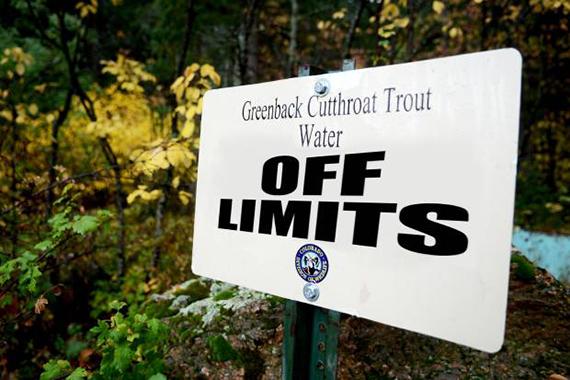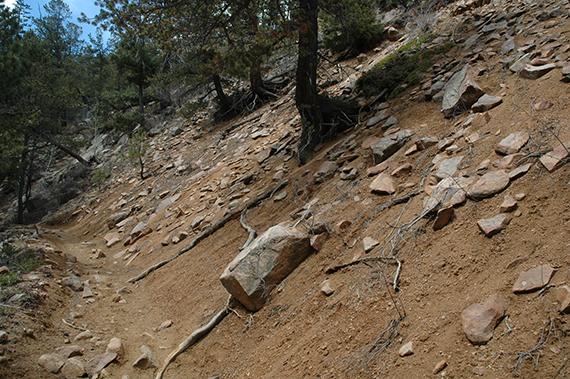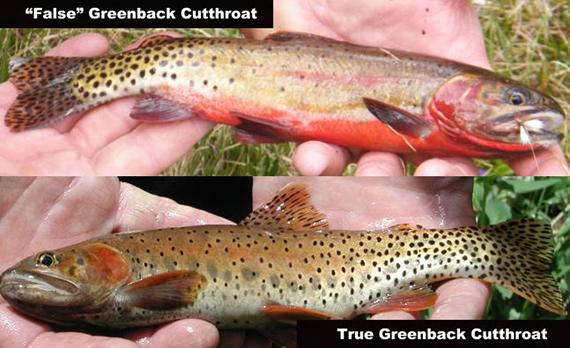Threatened Greenbacks could become “Endangered”
 Sometimes you have to move slow to go fast. That’s the case with Bear Creek Watershed Restoration Project and protecting the only pure strand of Colorado Greenback Cutthroat Trout left in the world. To move too fast could mean huge setbacks to the process and could threaten not only the preservation and conservation of the Greenbacks but also impede progress on accessing the Bear Creek Watershed and its trail system. Where are we currently in the process and what looks like next steps in the future for the Greenback Cutthroat Trout and the Bear Creek Watershed?
Sometimes you have to move slow to go fast. That’s the case with Bear Creek Watershed Restoration Project and protecting the only pure strand of Colorado Greenback Cutthroat Trout left in the world. To move too fast could mean huge setbacks to the process and could threaten not only the preservation and conservation of the Greenbacks but also impede progress on accessing the Bear Creek Watershed and its trail system. Where are we currently in the process and what looks like next steps in the future for the Greenback Cutthroat Trout and the Bear Creek Watershed?
“Threatened” vs. “Endangered”
The Greenback Cutthroat Trout is considered a “threatened” species. Biologists in Colorado want to keep them that way and NOT shift to an endangered listing. The key federal protections and consultation requirements are in place already since the fish is listed as “threatened”; there is no real reason for conservation interests to push for the up-listing to “endangered.”
Why is this important?
If we rush the process of restoring the Bear Creek Watershed too quickly, we run the risk of having the status of the Greenback Cutthroat Trout shifted from “threatened” to “endangered.” What’s the difference — and why does it matter?
Endangered species – are at the brink of extinction now.
Threatened species – are likely to be at the brink in the near future.
A change in the designation would mean that efforts to repopulate the fish in other areas of the state — which is currently in its very initial stages — could be stalled. A focused effort by many groups — the U.S. Fish and Wildlife Service, the National Forest Service, Colorado Division of Parks and Wildlife — is headed in the right direction for long-term preservation of the Greenback Cutthroat Trout.
Populating Efforts
 The “threatened” listing gives the biologists more flexibility on recovery actions and in allowing continued catch-and-release angling as they establish new sites. Some of the work being done right now includes preparing and studying sites for relocating and populating the Greenback species:
The “threatened” listing gives the biologists more flexibility on recovery actions and in allowing continued catch-and-release angling as they establish new sites. Some of the work being done right now includes preparing and studying sites for relocating and populating the Greenback species:
- Preparing Zimmerman Lake near Fort Collins / Walden for possible stocking at the end of the summer.
- Square Tops Lakes / Duck Creek, near Guanella Pass, will also be treated this summer. They believe they can get natural reproduction in the lower portion of the watershed … and possibly put native greenbacks in by fall or possibly next year.
- Dry Gulch / Herman Gulch, in the Clear Creek headwaters, are two potential small population sites (about 2- 2.5 miles each); Dry Gulch currently holds “blue” lineage fish. They would like to move forward on one of these streams in 2014 if possible.
Other areas in the state that are being considered for repopulating with Greenback Cutthroat Trout include Rock Creek, a tributary to Tarryall; George and Cornelius Creek – a larger complex of about 14 miles; and Sheep Creek and Roaring Creek. These last two sites have strong cutthroat populations of blue fish (once thought to be greenbacks) and they wish to assess them for feasibility of reclamation projects to go back in with Bear Creek greenbacks.
Bear Creek Trail Restoration
 In general, by pushing the work too quickly or pushing the opening of the Bear Creek area could result in a change to “endangered” status that could handcuff current processes and efforts underway. If concerned groups attempt to “force” the opening of Bear Creek trail system, conservation groups will then be forced to change the status of the Greenbacks from “threatened” to “endangered” resulting in everyone losing.
In general, by pushing the work too quickly or pushing the opening of the Bear Creek area could result in a change to “endangered” status that could handcuff current processes and efforts underway. If concerned groups attempt to “force” the opening of Bear Creek trail system, conservation groups will then be forced to change the status of the Greenbacks from “threatened” to “endangered” resulting in everyone losing.
The Rocky Mountain Field Institute (RMFI), in conjunction with the National Forest Service, are taking steps to assess the condition of the trails and to restore the trails for access. Specifically, a number of steps are being taken right now regarding the trail system in the Watershed.
The Forest Service will utilize the results of RMFI’s assessment to determine the feasibility of reopening the trail system closed by Forest Order 14-2. Efforts are continuing to utilize the scientific knowledge to identify new or substantially improved systems, processes, and procedures for the effective rehabilitation of trails contributing sediment to Bear Creek. Discussion about reopening Palmer Loop from High Drive is ongoing and a decision is expected next week.
Other work spearheaded by the RMFI includes
- looking for a sustainable trail into Jones Park from the south. If a trail alignment is found that provides access to some of the historic sites while not impacting the Greenback cutthroat trout, it will be included in the proposed action.
- looking at a new 668-701 connection that will be closer to the current 720 alignment. The new alignment will travel through some of the nicest areas along 720, but will stay out of the Bear Creek watershed.
- adjusting the “travel restricted to trail” boundary to allow access to the summits of Specimen and Sentinel rocks, Runs-down-fast Mountain, Tuckaway Mountain, Mays Peak and Mount Buckhorn.
 We need to keep on track with the work that is being done now. The steady and consistent work to prepare for repopulating the Greenback Cutthroat in different waters throughout the state are the right efforts. Similarly, the work being done locally to restore the trail system for multi-use — while protecting the current population of this threatened species — is the right work to be done.
We need to keep on track with the work that is being done now. The steady and consistent work to prepare for repopulating the Greenback Cutthroat in different waters throughout the state are the right efforts. Similarly, the work being done locally to restore the trail system for multi-use — while protecting the current population of this threatened species — is the right work to be done.
Let’s not act in ways that undermine those efforts. Let’s be deliberate and thoughtful in our actions. The right steps taken now — with study and with patience — will have long term positive effects for all concerned.
We need to let the government do their job and keep this ball moving. Any distraction will slow the process, slow the recovery, and slow the opening of Bear Creek.
David Leinweber
